Celebrating the Birthday of Paul Signac
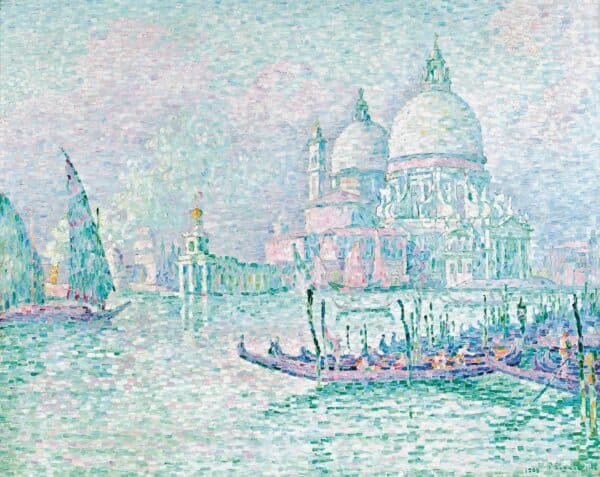
Paul Signac, Venice. La Salute. Vert, 1908, Oil on Canvas
Today we are celebrating the birthday of French Neo-Impressionist painter, Paul Signac. Born in Paris on the 11th of November, 1863, Signac is often referred to as a follower and disciple of George Seurat (the father of Neo-Impressionism and the Pointillist technique). Seurat was also a close friend and colleague of Signac and, having looked just last month at Pointillism, it seems apt that we explore the life and work of Seurat’s closest associate.
Signac was a highly accomplished painter in his own right, whose work and style was a pillar in the ever evolving movements of modern art. Therefore, it feels only right to have a look at his life and celebrate his work, outside of the shadow of Seurat!
A Brief Biography of Paul Signac
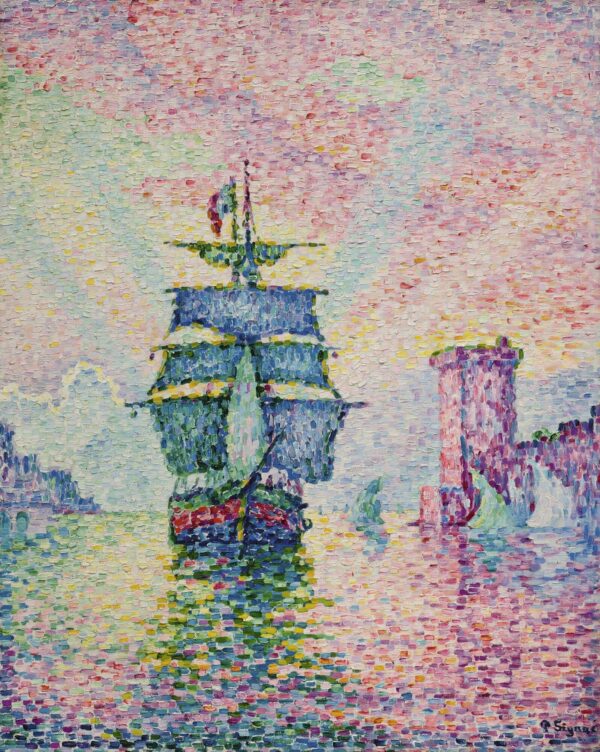
Paul Signac, La Passé de Marseille, 1910-1911, Oil on Canvas
Paul Signac was a quintessential figure in the 19th century Paris art scene. Having grown up in a middle class household and been raised by a close, supportive family, he was encouraged to visit exhibitions and immerse himself in art from childhood. Though he originally started his studies in architecture, Signac was only 18 when he decided to dedicate himself to the world of art and painting.
Unsurprisingly, given the epoch in which Signac collided with that world, he was greatly inspired by the work of Monet and other primary Impressionist painters. Given his artistic environment, the Impressionist approach to colour, light and composition firmly asserted itself into Signac’s own self-taught practices.
Whilst Signac exhibited alongside the Impressionists, a defining moment in his career was his introduction to George Seurat in 1884 (which we will come to shortly). Dissatisfied with the official Salon, artists such as Signac and Seurat sought to create a space for the work that did not meet the old-fashioned academic ideals, and both assisted in the founding of the annual Salon des Independent.
In alignment with the Impressionist movement, Signac painted many landscapes, genre scenes and depictions of the sea. His love of sailing and the mediterranean coastline (he bought a home when St. Tropez was still considered to be a little fishing village) both played a large role when it came to his subject matter.
Tranquil harbour scenes and beautiful conjurings of sunsets over the ocean became his favourite subjects. Especially later on in his life when his use of colour simultaneously became bolder, more expressive and ethereal.
Paul Signac’s Politics
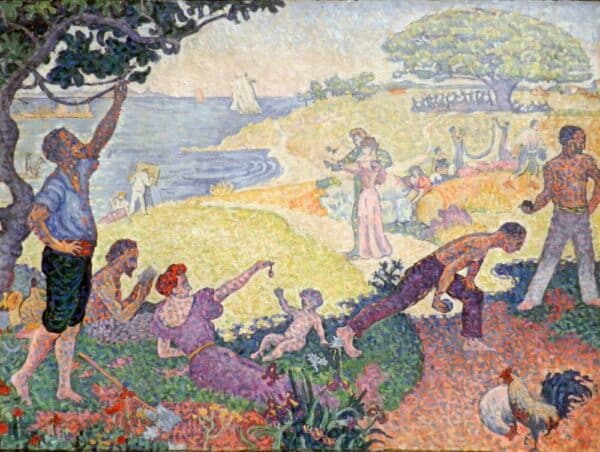
Paul Signac, In the Time of Harmony: The Golden Age Has Not Passed, It Is Still to Come (Reprise), 1896, Oil on Canvas
Like many members of the avant-garde art movements, Paul Signac had some strong opinions on the social and political world in which he lived. In 1888 Signac was famed for publicly endorsing anarchism and was also a regular donator to the pro-anarchist and communist newspaper Le Nouveau Temps (The New Times).
Like many modern artists in the 18 and 1900s, these political views were often expressed through the mode of their paintings – some being more subtle than others.
For example, in 1893, Signac painted a scene of a future pastoral utopia. The piece has been understood to be Signac’s (non-violent) method for advocating anarchy and how, through it, peace, freedom and bohemia could be achieved. At first titling the work “In the Time of Anarchy”, Signac later changed the title to “In the Time of Harmony” because of the rise in persecution of the movement by French authorities.
Signac, Seurat and the Development of Pointillism
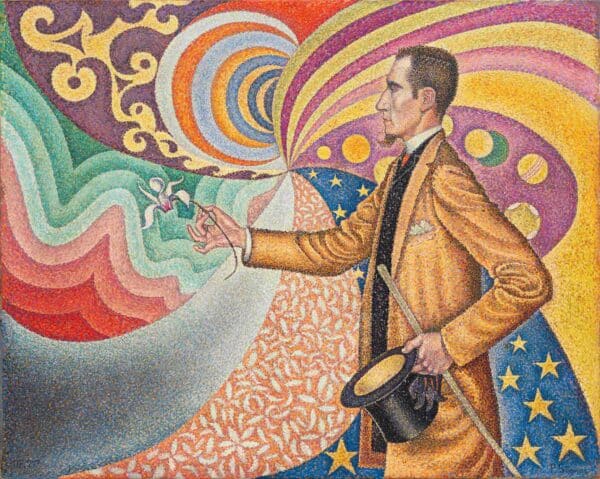
Paul Signac, Opus 217. Against the Enamel of a Background Rhythmic with Beats and Angles, Tones, and Tints, Portrait of M. Félix Fénéon in 1890, 1890, Oil on Canvas
Whilst our main aim with this piece is to dedicate our full attention to Signac’s life, a key part of his timeline was the relationship he had with George Seurat. The time the two artists spent together is more or less responsible for Signac’s style, artistic output and legacy.
Ultimately, when it came to colour, the Impressionists were predominantly concerned with light and how they were to capture its fleeting impression on whatever it touched. However, Signac and Seurat were captured also by colour theory of Michel-Eugène Chevreul. They wanted to use his theories to develop a painting technique that meant the human eye did the laborious work of blending rather than it being pre-mixed, as it were, on the palette and then the canvas.
With this systematic approach as the driving force, Seurat developed Pointillism. A method of applying paint in the form of multiple single dots or daubs, which you can read more about here in our last month’s journal! Whilst Seurat is often considered the leader of this technique, we must recognise Signac as its key promulgator after Seurat’s tragically early death in 1891.
Without Signac to champion Pointillism in the way he did, we may not have seen the Neo-Impressionist movement continue to influence in the way that it did.
The Colour Blue in Signac’s Paintings
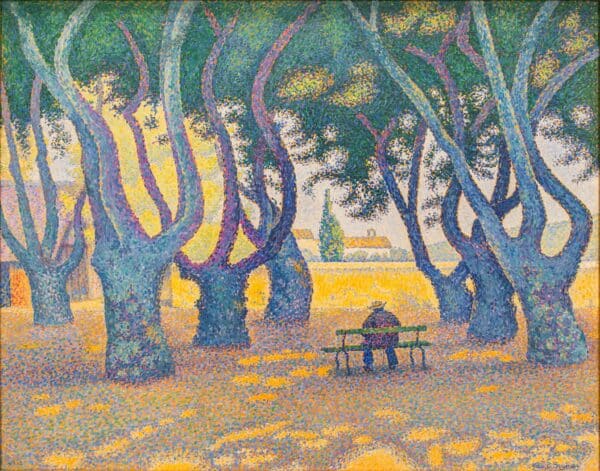
Paul Signac, Place des Lices, St. Tropez, 1893, Oil on Canvas
Signac was undeniably an incredible colourist. The bright and varied palettes used within his oeuvre demonstrates the artist’s fundamental love for colour and its expressive qualities. The colour blue being one of great significance in his work.
For instance, in Signac’s 1893 work Place des Lices, not only is the viewer informed by blue and its connotations, but we are presented with a perfect example of the Pointillist primary colour theory being used. Signac’s interest in structural form is also obvious in this work as the use of line and shape plays an important part in the composition.
Like with many Impressionist and Neo-Impressionist works of art, Place des Lices initially appears to be a simple outside genre scene. We see a single figure sitting on a bench in the clearing between a number of solid, sinuous trees. The blue of the trunks and the figure itself create an aura of solitary introspection, whilst the bright yellows of the view beyond counterbalance this and hint at brighter days to come.
Furthermore, the blues and violates that dominate the trunks of the trees are accompanied by dots of orange and yellow. This combination of bright unmixed colours is meant to accentuate the blues of the trees as the viewer looks upon the piece; the human eye blending the colours more efficiently than a palette could.
Blue is prominent in a large number of Signac’s paintings, given his favouring of the sea and the sky. Used as a magical and malleable colour in all its shades and hues, Signac’s work does everything to support our belief that blue is one of the most multi-functional colours we have!
Signac and His Legacy

Paul Signac, Antibes. Morning, 1914, Oil on Canvas
As with all of the artists we celebrate in our birthday journals, it is impossible to talk about every aspect of their fascinating lives. Paul Signac is no exception. He settled in Antibes in 1913 and remained based there until his death in 1935, producing many sea views like the one above.
With an oeuvre of over 500 wonderful artworks, a manifesto for the Neo-Impressionist movement and legacy in colour, style and politics, Paul Signac is well and truly worth celebrating.
“By the separation of tones, by the use of pure color,
by the balancing of complementary colors,
the Neo-Impressionist ensures the harmony and brilliance of his canvas.”
Paul Signac, “From Eugene Delacroix to Neo-Impressionism” (1899)